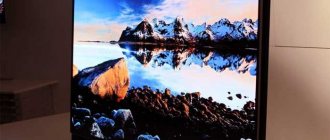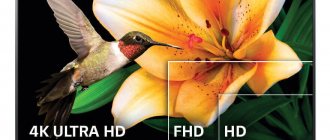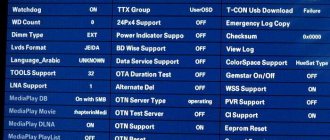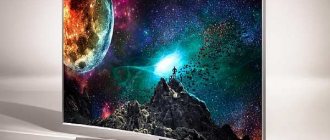How much better is an 8K TV than a 4K TV, and is our vision capable of reliably distinguishing such picture resolutions? There are a lot of discussions on this topic. And now, finally, a completely scientific study of this issue has been published.
I have long argued that the benefit of 8K displays is not the increased number of pixels. This parameter has a limit that a person can distinguish when viewing at a normal distance - and going beyond this limit does not provide any benefit.
But where exactly is this limit? More specifically, do 8K displays have any advantage in terms of perceived detail over 4K under normal viewing conditions? Not long ago I asked myself this question.
Warner Bros. was a well-designed, double-blind study in collaboration with Pixar, Amazon Prime Video, LG and the American Society of Cinematographers (ASC). His goal is to understand whether people can tell the difference between 4K and 8K when viewing different content.
First, let me remind you: 4K is a resolution of 3840x2160, and 8K is a resolution of 7680x4320. However, as you probably already know, these definitions are slightly incorrect because... in fact, 4K has a resolution of 4096x2160, and 8K has a resolution of 8192x4320. But these designations were created by the consumer electronics industry for use in related television solutions, so that's what I'll use.
Selection and preparation of content
A total of seven uncompressed excerpts were produced in the original 8K format, each approximately 10 seconds long. Two clips were taken from the Warner Bros. film. Dunkirk: 8K scans of 70mm film, character close-up and wide shot of the beach.
Animated clips from Pixar's Brave and Bug's Life were rendered in 8K for our study. Two clips from Amazon's live-action series The Tick were also featured, one filmed in a cave and one filmed in a spaceship using a Red 8K digital cinema camera, as well as a nature clip shot by Stacey Spears ).
All seven video clips were originally shot in HDR and then encoded in HDR10. Here are the HDR10 stats for each clip.
All seven clips were encoded in HDR10. This table shows the MaxFALL (maximum average frame light level) and Max CLL (maximum content light level) of each clip. As you can see, there is a wide range of average and maximum light levels
Each of the excerpts was cut down to 4K using standard Nuke post-production software. The 4K video was then "upscaled" back to 8K using Nuke's cube filter, which basically duplicates each pixel four times with a bit of anti-aliasing, so the final image is 4K in an 8K "container".
Why was 4K upscaled back to 8K? Because both versions will be played on the same 8K display randomly (with minimal pauses). To play back the 4K and 8K versions of each clip smoothly, without HDMI glitches or display startup glitches when momentarily showing the input resolution, they both need to "look" like 8K to the display.
Test equipment and procedure itself
The screen on which all the excerpts were shown was an 88-inch 8K OLED-TV LG 88Z9. All videos were downloaded to a Windows PC with an 18-core Intel Core i9 processor, an SSD RAID drive, and an Nvidia 1080TI graphics card.
The BlackMagic 8K Pro video interface outputs video via four 12G SDI channels to four AJA Hi5-12G SDI-to HDMI converters, which output HDMI 2.0. Four converters sent HDMI 2.0 to the Astrodesign SD-7075, which converted them into a single HDMI 2.1 bitstream - which was then output to the TV.
The playback system required some hardware to handle uncompressed 8K footage
Uncompressed files were played back in professional DPX format at 24 frames per second. They were encoded with 10-bit precision in BT.2100, which uses the BT.2020 color gamut and PQ EOTF (electro-optical transfer function) - the standard for HDR10. These files require a constant file reading speed of at least 3 GB/s (yes, exactly three gigabytes per second!) - which is why such a serious hardware system was necessary.
A total of 139 people took part in the study, which was conducted over three days. Five people participated in each session, which lasted about 30 minutes. Two participants sat in the front row, approximately 1.5 meters from the screen, and three in the back, approximately 2.5–3 meters from the screen. Note that 2.7 meters from the screen is equal to two screen heights, and the ITU (International Telecommunication Union) has determined that this is the average viewing distance at home, regardless of screen size.
During each session, 4K and 8K versions of each clip were played in three sequences. For the first two 4K and 8K versions, the labels "A" and "B" were randomly assigned and they were played twice in alternation - that is, ABAB, after which participants indicated which one looked better on the scoring sheet.
In the third sequence, the 4K version was played four times, although participants still saw the alternating labels “A” and “B” and assigned points as before. This provided a control group for more reliable statistics.
Participants entered a rating after viewing each sequence, indicating whether passage A or B was a little better, better, much better, or the same
During each session, participants saw one sequence from one clip, then a sequence from another clip, and so on in random order until all sequences were presented. Participants never saw two sequences from the same clip played one after the other.
Visual acuity assessment
Before testing began, each participant was tested for visual acuity - after all, the study would be pointless if they couldn't perceive fine detail. All were subjected to a standard visual acuity test using the Snellen chart used in optometry offices.
One way to quantify visual acuity is to use two numbers expressed as "20/X", where 20/20 is considered normal - that is, at a distance of 20 feet (about 6 m), a person with 20/20 visual acuity can see the same level detail as a person with normal acuity at this distance.
A visual acuity of 20/200 means that at 20 feet you can discern the same level of detail as a person with normal visual acuity at 200 feet - not very good!
Conversely, 20/10 visual acuity means that at 20 feet you can discern the same level of detail that a person with normal visual acuity can discern at 10 feet—in other words, better than normal.
Most participants (61%) had 20/20 vision or better
As I had hoped in this study, most participants had visual acuity of 20/20 or better: 27% were better than 20/20, 34% were at 20/20, and another 39% were worse than 20/20, although most of them scored 20/25 or 20/30.
Test results
The price category up to 140,000 rubles includes a wide range of 4K TVs from 40 to 65 inches. However, not all devices impress with image quality and equipment.
Test winner: LG 65UB950V is the most expensive TV among those tested, but its price is well justified by its excellent display and high ratings. The device also copes well with content playback.
Best choice: Samsung UE40HU7000U is one of the most affordable 4K TVs on the market with a 40-inch display. It demonstrates fairly good image quality and has very rich equipment.
A good buy: the LG 55UB850V is quite a bit behind the test winner, while it costs half as much, and the Philips 49PUS7909 is even more affordable with similar scores.
Test results
The results were tabulated in several ways. On average across all results, 8K video was rated "slightly better" than 4K. The average value was no more than 0.252 - that is, a quarter of the “slightly better” value.
The figure also shows that the average results of participants with 20/20 vision were higher. In this case, the average leaned a little more toward 8K for some clips, but a little less for other clips.
On average across all results (left), the 8K versions were rated "slightly better" than the 4K versions. On average, results for participants with visual acuity of 20/20 or better (right) showed little change.
Now let's look at the average results of participants with 20/10 visual acuity sitting in the front row. The 8K versions of two videos—"Bug's Life" and Stacey Spears' nature footage—scored slightly higher, almost entirely "a little better." The remaining passages were scored with minor deviations.
The results of this group of participants were particularly noteworthy because, according to a more precise definition of visual acuity limits, they were able to fully discern 8K resolution on an 88-inch screen from that distance.
Average results for participants with 20/10 visual acuity sitting in the front row (five feet from the screen) show that clips from "A Bug's Life" and Stacey Spears' nature footage were rated higher than other clips, but still only "slightly better" than 4K
In a different way of processing the results, all responses of “a little better,” “better,” and “much better” were combined into a single score of “better.”
Michael Zink, vice president of technology at Warner Bros., one of the study's authors, explained: “The goal was to take nuance out of equality. What may be “a little better” for one person could potentially be “a lot better” for another person – in terms of differences in perception. Essentially, we wanted to see the difference between people rating “same” and “better.” These results are presented on the right half of the graph below.
Another interesting type of data is presented in the left half. The graph shows the distribution of three types of answers (4K is better than 8K; two versions are the same; 8K is better than 4K). Interestingly, Stacey Spears' nature footage had a different score distribution than other clips, with the 8K version scoring better than the 4K version.
The graph on the left shows the distribution of ratings where the 4K version is better than the 8K version (blue), both versions are rated equally (orange), and the 8K version is better than the 4K version (green). The graph on the right shows the results when three different "better" ratings on each side were combined into a single "better" rating.
I was amazed to see how much higher the 4K version scored than the 8K version. When I asked Michael Zink about this, he responded, “I think the reason a lot of people say, '4K is better than 8K,' is because they don't really know the difference and are just guessing.
More interesting is the fact that for all clips except clip 7—the “nature video”—the majority of people responded, “4K is the same as 8K.” And “8K is better than 4K” is the second highest scoring option. For clip 7 things are different and most people think that "8K is better than 4K".
Various equipment
LG 55UB850V (second place) is ideal for watching blockbusters in rich colors. The built-in audio system of this TV also deserves praise: the sound is clear, without rattling or distortion, and a decent low-frequency range. The last position in this criterion is occupied by 55-inch Thomson and TCL TVs, which are equipped with two ten- and eight-watt speakers, respectively, without a subwoofer. Therefore, the sound is very “flat”, and as the volume increases, the speakers begin to rattle.
LG 55UB850V: 2nd place in the test
When assessing the equipment, TV interfaces played a secondary role, since HDMI and USB connectors on all devices are presented in sufficient quantities. A network port and a built-in WLAN module are also provided. In addition to hardware, such features as the presence of a full-fledged browser, a second remote control and Smart TV capabilities were taken into account. The richest Smart TV options today are offered by Samsung TVs, but LG, Philips and Sony are very close behind.
We also note that we tested playback of 4K content in H.265 format from an external USB drive. This task was failed one after another by TCL U55S7606DS, Thomson 55UZ8766 (twelfth place), Grundig 55VLX8481 (tenth place), Panasonic TX-40CXR700 (ninth place), Samsung UE55HU7200 (seventh place) and Philips 55PUS7809 (sixth place). Playback is only possible if the previous H.264 format is used, but due to the lower compression ratio the data volumes are much higher.
How CHIP tests TVs
Image quality has been and remains the main criterion when buying a TV. However, in addition, the TV must be richly equipped, have easy controls, high-quality built-in sound and consume little electricity.
Image quality (50%) We determine color space, gamma curve deviation, brightness and contrast using a video photometer. In the same way, we establish the exact dependence of color and contrast on the viewing angle.
Equipment (25%) This evaluates the number of interfaces and tuners, as well as 3D technology, Internet and Smart TV functions, a media player, additional remote controls and image adjustment options.
Ergonomics (15%) A clearly structured on-screen menu and convenient placement of connectors play an important role.
Image quality (5%) Important criteria: good sound pressure, low clearing factor and good frequency response.
Energy efficiency (5%) We detect the energy consumption of the TV in operating mode, eco mode and standby mode.
The testing method for 3D television cameras involves fixing 3D glasses in front of a professional photometer Opteema LMK 98-3









